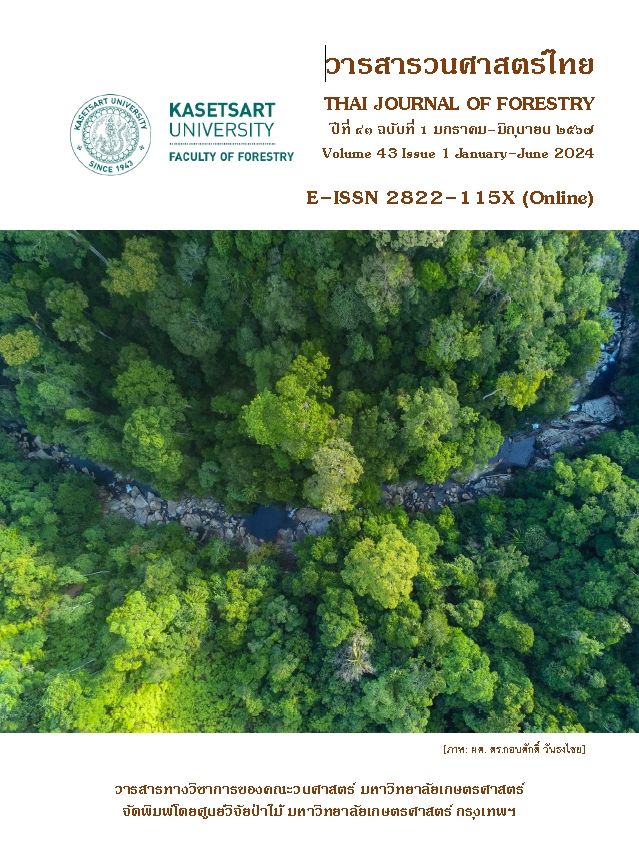การประยุกต์ใช้แบบจำลอง SWAT เพื่อวิเคราะห์ปริมาณน้ำท่าเชิงพื้นที่ จากการเปลี่ยนแปลงการใช้ประโยชน์ที่ดินบริเวณลุ่มน้ำสาขาน้ำแม่สรวย จังหวัดเชียงราย
Main Article Content
บทคัดย่อ
ลุ่มน้ำสาขาน้ำแม่สรวยมีปัญหาด้านทรัพยากรน้ำทั้งน้ำท่วมและขาดแคลนน้ำทุกปี ปริมาณน้ำต้นทุนที่จะไหลลงสู่อ่างเก็บน้ำแม่สรวยอาจะมีการเปลี่ยนแปลงไปเนื่องจากการเปลี่ยนแปลงการใช้ที่ดิน ดังนั้นจึงประยุกต์ใช้แบบจำลอง Soil and Water Assessment Tool (SWAT) เพื่อประเมินปริมาณน้ำท่าเฉลี่ยและวิเคราะห์สมดุลน้ำจากการเปลี่ยนแปลงการใช้ประโยชน์ที่ดินในปี พ.ศ.2556 และ 2561 ผลการศึกษาพบว่า แบบจำลอง SWAT มีประสิทธิภาพในการประเมินปริมาณน้ำท่าและการวิเคราะห์สมดุลน้ำของลุ่มน้ำสาขาน้ำแม่สรวย โดยผลการปรับเทียบแบบจำลองให้ค่า R2 เท่ากับ 0.80 ค่า NSE เท่ากับ 0.76 และค่า PBIAS เท่ากับ -9.2 ซึ่งพบว่าในช่วงปีพ.ศ. 2556 และ 2561 มีการลดลงของพื้นที่ป่าไม้ร้อยละ 2.9 เปลี่ยนเป็นพื้นที่เกษตรกรรมและที่อยู่อาศัย ทำให้ปริมาณน้ำท่ารายปีเฉลี่ยลดลงน้อยกว่าร้อยละ 1 แต่จะสังเกตได้ว่าปริมาณน้ำท่าช่วงแล้งฝนลดลงประมาณร้อยละ 2 โดยเฉพาะในช่วงปลายฤดูฝนตั้งแต่เดือนตุลาคมถึงธันวาคม เนื่องจากปริมาณน้ำฝนที่ลดลงแล้วยังมีสาเหตุจากการลดลงของพื้นที่ป่าไม้เป็นพื้นที่เกษตรกรรมทำให้เกิดการสูญเสียน้ำจากการคายระเหยเพิ่มขึ้นร้อยละ 2.0 ทำให้น้ำในดินและน้ำไหลในลำธารมีปริมาณลดลง และผลผลิตน้ำของลุ่มน้ำมีปริมาณลดลงเล็กน้อย สรุปได้ว่าปริมาณน้ำท่าและสมดุลน้ำของลุ่มน้ำสาขาน้ำแม่สรวยลดลงจากการเปลี่ยนแปลงการใช้ที่ดินไม่มากนัก (ลดลงไม่เกินร้อยละ 2)
Downloads
Article Details

อนุญาตภายใต้เงื่อนไข Creative Commons Attribution-NonCommercial-NoDerivatives 4.0 International License.
ข้าพเจ้าและผู้เขียนร่วม (ถ้ามี) ขอรับรองว่า ต้นฉบับที่เสนอมานี้ยังไม่เคยได้รับการตีพิมพ์และไม่ได้อยู่ในระหว่างกระบวนการพิจารณาตีพิมพ์ลงในวารสารหรือสิ่งตีพิมพ์อื่นใด ข้าพเจ้าและผู้เขียนร่วม (ถ้ามี) ยอมรับหลักเกณฑ์และเงื่อนไขการพิจารณาต้นฉบับ ทั้งยินยอมให้กองบรรณาธิการมีสิทธิ์พิจารณาและตรวจแก้ต้นฉบับได้ตามที่เห็นสมควร พร้อมนี้ขอมอบลิขสิทธิ์ผลงานที่ได้รับการตีพิมพ์ให้แก่วารสารวนศาสตร์ คณะวนศาสตร์ มหาวิทยาลัยเกษตรศาสตร์ กรณีมีการฟ้องร้องเรื่องการละเมิดลิขสิทธิ์เกี่ยวกับภาพ กราฟ ข้อความส่วนใดส่วนหนึ่ง หรือ ข้อคิดเห็นที่ปรากฏในผลงาน ให้เป็นความรับผิดชอบของข้าพเจ้าและผู้เขียนร่วม (ถ้ามี) แต่เพียงฝ่ายเดียว และหากข้าพเจ้าและผู้เขียนร่วม (ถ้ามี) ประสงค์ถอนบทความในระหว่างกระบวนการพิจารณาของทางวารสาร ข้าพเจ้าและผู้เขียนร่วม (ถ้ามี) ยินดีรับผิดชอบค่าใช้จ่ายทั้งหมดที่เกิดขึ้นในกระบวนการพิจารณาบทความนั้น”
เอกสารอ้างอิง
Chilagane, N., Kashaigili, J., Mutayoba, E., Lyimo, P., Munishi, P., Tam, C., Burgess, N. 2021. Impact of land use and land cover changes on surface runoff and sediment yield in the Little Ruaha River Catchment. Open Journal of Modern Hydrology, 11, 54-74. doi:10.4236/ojmh.2021.113004.
Gupta, H.V., Sorooshian, S., Yapo, P.O. 1999. Status of automatic calibration for hydrologic models: Comparison with multilevel expert calibration. Journal of Hydrologic Engineering, 4(2): 135-143. doi.org/10.1061/(ASCE)1084-0699(1999)4:2(135)
Fernandez, G., Chescheir, G., Skaggs, R., Amatya, D. 2005. Development and testing of watershed-scale models for poorly drained soils. American Society of Agricultural and Biological Engineers, 48:639-652. doi.org/10.13031/2013.18323
Hong, Z., Wang, B., De, L.L., Mingxi, Z., Lance, L.M., Qiang, Y. 2020. Using an improved SWAT model to simulate hydrological responses to land use change: A case study of a catchment in tropical Australia. Journal of Hydrology, 585: 124822. doi.org/10.1016/j.jhydrol.2020.124822
Hydro Informatics Institute. 2018. Basic Information of 25 River Basins in Thailand: Kok River Basin. https://www.senate.go.th, 10 April 2022. (in Thai)
Land Development Department. 2013. The Data of Classification Land Use Type 2013. http://dinonline.ldd.go.th, 7 November 2021. (in Thai)
Moriarty, P., Batchelor, C., Abd-Alhadi, F., Laban, P., Fahmy, H. 2007. The EMPOWERS Approach to Water Governance: Guidelines, Methods and Tools. https://www.ircwash.org/sites/default/files/empowers_guidelines_methods_and_tools.pdf, 4 March 2022.
Moriasi, D., Arnold, J., Van, L.M., Bingner R., Harmel R.D., Veith, T. 2007. Model evaluation guidelines for systematic quantification of accuracy in watershed simulations. Transactions of the ASABE, 50(3): 885-900. doi.org/10.13031/2013.23153
Nandini, R., Kusumandari, A., Gunawan, T., Sadono, R. 2019. Assessment of land use impact on hydrological response using soil and water analysis tool (SWAT) in Babak Watershed, Lombok Island, Indonesia. Agriculture and Natural Resources, 53(6): 635–642.
Nash, J.E., Sutcliffe, J.V. 1970. River flow forecasting through conceptual models, part 1: A discussion of principles. Hydrology, 10(3): 282-290.
Neitsch, S.L., Arnold, J.G., Kiniry, J.R., Srinivasan, R., Williams, J.R. 2005. Soil and Water Assessment Tool Input/Output File Documentation (Version 2005). http://swatmodel.tamu.edu/media/1291/SWAT2005io.pdf, 4 March 2022.
Sahu, M., Lahari, S., Gosain, A., Ohri, A. 2016. Hydrological modeling of Mahi Basin using SWAT. Journal of Water Resource and Hydraulic Engineering, 5: 68-79. doi.org/10.5963/JWRHE0503001.
Sujira, S. 2019. Climate Change and Land Use Change on Water Accounting in Upper Nan Sub-Watershed. M.S. Thesis, Kasetsart University, Bangkok, Thailand. (in Thai)
THAICID. 2020. Manual on Planning of Structural Approaches to Flood Management. Mittrapap Karnpim and Studio, Bangkok, Thailand. (in Thai)


